How To Sharpen a Knife
- January 30, 2024
- 0 comment
A sharp knife is a chef’s best friend. Not only does it make cutting and slicing more efficient, but it also ensures safety in the kitchen. A dull knife can be dangerous, as it requires more force and can slip easily, leading to potential accidents. Furthermore, a well-maintained, sharp knife can enhance the precision of your cuts, ensuring that your culinary creations are not only delicious but also aesthetically pleasing. This article will guide you through the process of sharpening your knives, ensuring they are always in top condition, and ready to handle any task with ease and accuracy.
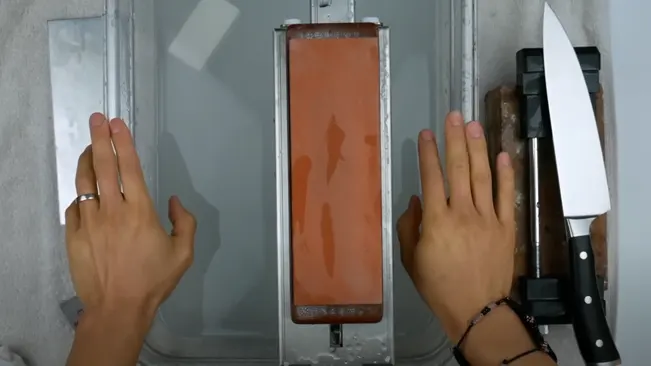
Understanding Knife Anatomy
Before sharpening a knife, it’s essential to understand its anatomy. The anatomy of a knife is not just about recognizing its parts. It’s about appreciating the intricate design and engineering that goes into creating a tool that’s both functional and safe. Whether you’re selecting a new knife, maintaining your current collection, or simply seeking to use one more effectively, this knowledge is invaluable. Embrace the art and science of knife anatomy, and let it guide you towards a more informed and skillful use of this timeless tool.
Types of Knife Sharpeners
Knife sharpening is an essential skill in both professional and home kitchens, and choosing the right type of sharpener is crucial. The three primary types of sharpeners – whetstones, honing rods, and electric sharpeners – each have unique features and uses.
Whetstones
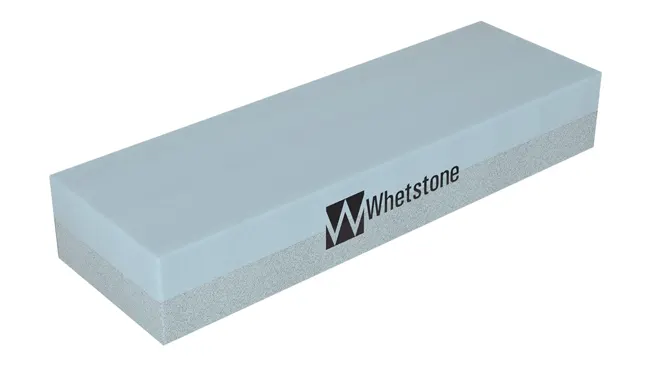
- Precision Control: Whetstones, also known as sharpening stones, offer the most control over the sharpening process. They allow for careful and precise sharpening of the knife’s edge.
- Skill and Practice: Mastering the use of a whetstone requires practice. The angle and pressure applied must be consistent to achieve a sharp edge.
- Grit Variations: Whetstones come in various grits, with lower numbers indicating coarser stones for repairing and sharpening dull blades, and higher numbers indicating finer stones for honing and polishing the edge.
- Versatility: Suitable for a wide range of knives, whetstones are preferred by chefs and knife enthusiasts for their ability to sharpen blades to a razor-sharp edge.
Honing Rods

- Edge Maintenance: Also known as sharpening steels, honing rods don’t actually sharpen but are used to maintain and straighten the edge of the knife. They are crucial for prolonging the sharpness achieved by a whetstone.
- Regular Use: Ideal for daily or regular use to keep a knife’s edge aligned and efficient.
- User-Friendly: Less skill-intensive than whetstones, honing rods are a quick and efficient way to maintain a knife’s edge, especially between more thorough sharpening sessions.
Electric Sharpeners
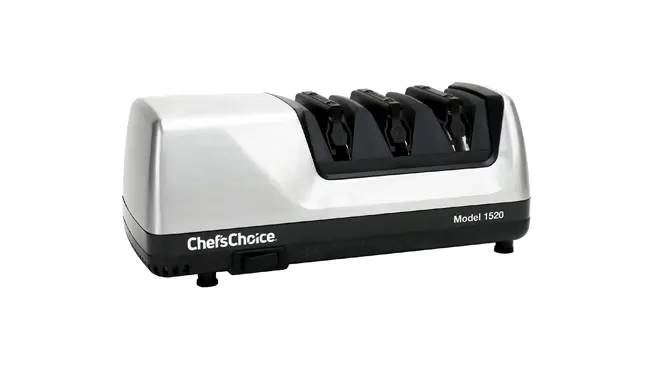
- Ease and Efficiency: Electric sharpeners are user-friendly and provide a quick way to sharpen knives. They are an excellent option for those who are not confident in their manual sharpening skills.
- Automated Sharpening: These devices often have built-in guides to assist in maintaining the correct angle, and multiple slots with varying degrees of coarseness for different sharpening stages.
- Consistency: Electric sharpeners ensure a consistent edge with minimal effort, though they may not offer the same level of precision as manual methods.
Each type of sharpener has its advantages, and the choice often depends on the user’s skill level, the types of knives being sharpened, and the desired level of precision. For the best results, it’s important to understand the specific needs of your knives and choose a sharpener accordingly.
Preparing to Sharpen Your Knife
Proper preparation is key to safely and effectively sharpening your knife. Here are the steps to ensure that you are ready to begin:
Clean Your Knife
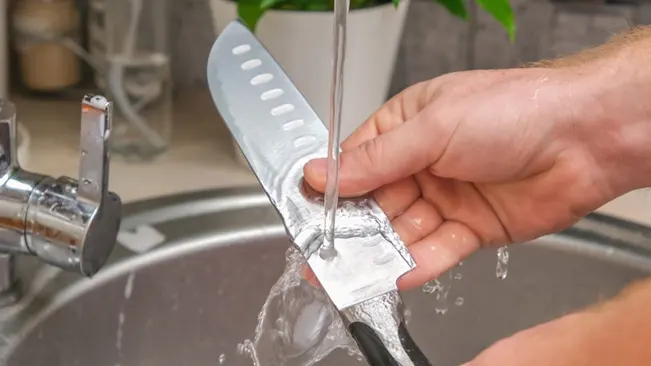
Remove Residue: Start by thoroughly cleaning your knife. Any residue or particles on the blade can affect the sharpening process and potentially damage the sharpener.
Dry Thoroughly: After cleaning, dry the knife completely to prevent slipping and to ensure a good grip during sharpening.
Secure Your Workspace
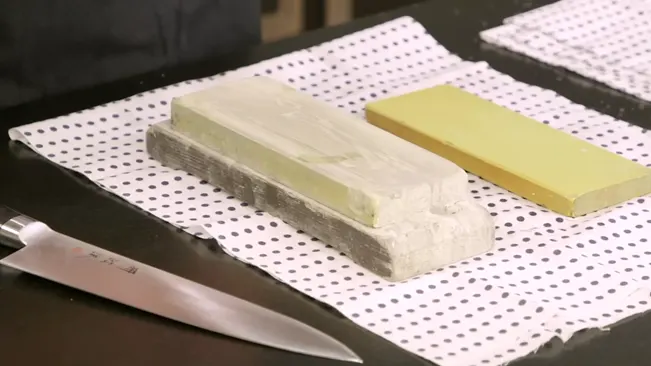
Stable Surface: Choose a stable and flat surface for sharpening. An unstable surface can lead to inconsistent sharpening and can be dangerous.
No Distractions: Ensure the area is free from distractions and interruptions. Concentration is key to both the quality of sharpening and your safety.
Wear Appropriate Safety Gear
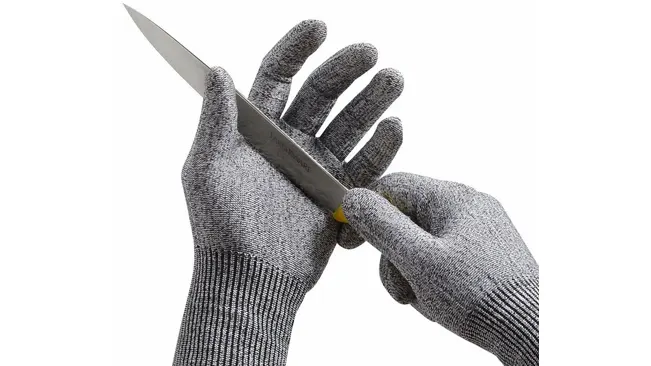
Cut-Resistant Gloves: If available, wear cut-resistant gloves on both hands. These gloves can protect your hands from accidental slips while sharpening.
Eye Protection: Consider wearing protective eyewear to safeguard against any potential flying debris or splinters, especially when using power sharpeners.
Proper Lighting and Visibility
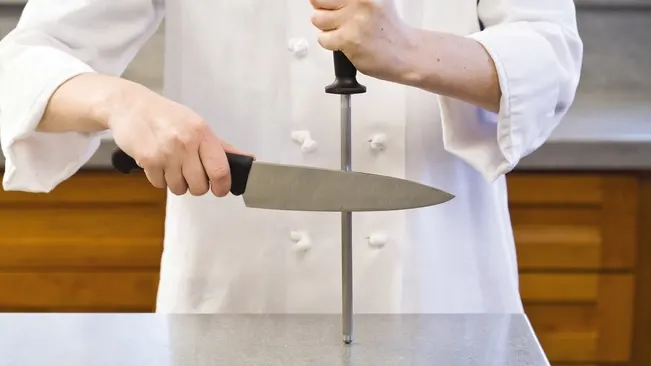
Good Lighting: Ensure that your workspace is well-lit. Good lighting is crucial for you to see the edge of the blade and the sharpener clearly.
Unobstructed View: Position yourself so that your view of the sharpening process is unobstructed. This helps in maintaining the correct angle and pressure.
Prepare Your Sharpening Tools
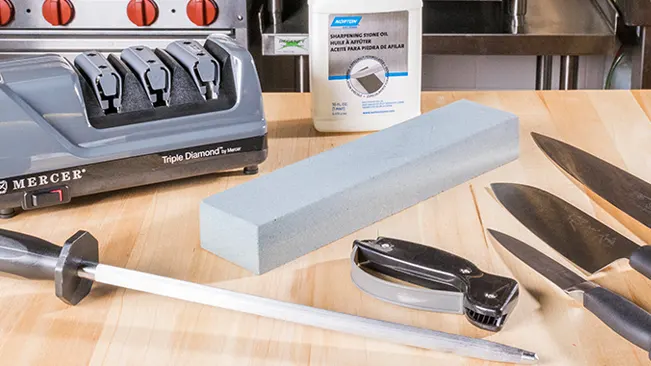
Ready the Sharpener: If using a whetstone, ensure it’s properly lubricated with water or oil, as recommended. For electric sharpeners, plug them in and make sure they’re functioning correctly.
Understand the Tool: Familiarize yourself with the sharpener’s features. If it’s your first time using a particular type, consider reading the instructions or watching a tutorial.
Mental Preparation
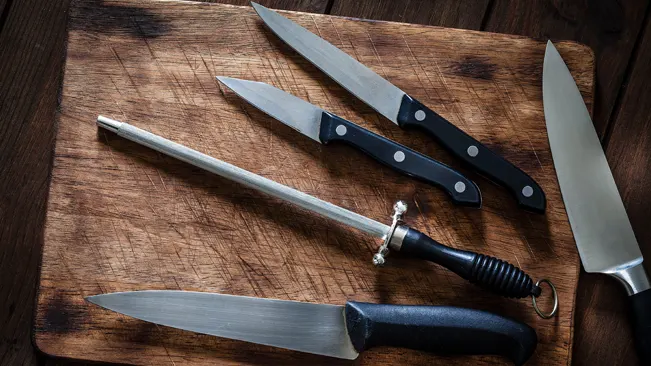
Focus and Patience: Sharpening a knife requires patience and attention. Approach the task with a calm and focused mindset.
Understand the Process: Have a clear understanding of the sharpening process you are about to undertake, including the number of strokes and the angle required.
By following these preparatory steps, you can ensure a safe and successful knife sharpening experience. Remember, the key to effective sharpening is not just the technique but also the preparation and attention to safety.
Sharpening Techniques
Sharpening a knife is both an art and a skill that can significantly extend the life and enhance the performance of your kitchen tools. Here are various techniques for sharpening knives, each suited to different types of sharpeners.
Using a Whetstone
Soak or Lubricate the Stone: Depending on the type of whetstone, it may need to be soaked in water or lubricated with oil before use.
Find the Right Angle: Hold the knife at the correct angle against the stone – typically between 15 to 20 degrees for most kitchen knives.
Sharpening Strokes:
- Glide the knife across the stone in smooth, controlled strokes, covering the entire length of the blade.
- Apply even pressure, and be consistent with the number of strokes on each side of the blade.
Grit Progression:
- Start with a coarser grit to sharpen dull edges.
- Progress to a finer grit for honing and polishing the edge.
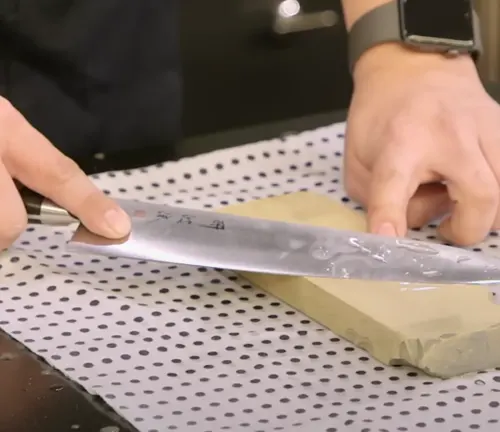
Honing with a Rod
Hold the Rod Securely: Grip the handle of the honing rod firmly and hold it vertically.
Angle of the Blade: Position the blade against the rod at the correct angle, usually around 20 degrees.
Sweeping Motion:
- Sweep the knife down the rod, moving from the heel of the blade to the tip.
- Repeat this motion several times on each side of the blade.
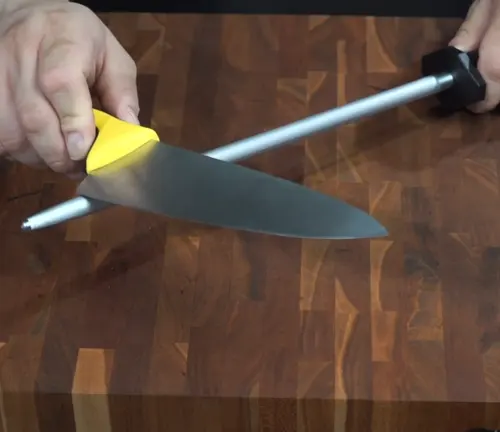
Using an Electric Sharpener
Turn on the Sharpener: Make sure the sharpener is stable on a flat surface.
Insert the Blade:
- Insert the blade into the slot at the base of the sharpener.
- Draw the knife through the slot with a slow, steady motion.
Multiple Stages:
- Most electric sharpeners have multiple stages for coarse sharpening and fine honing.
- Pull the knife through each stage as required.
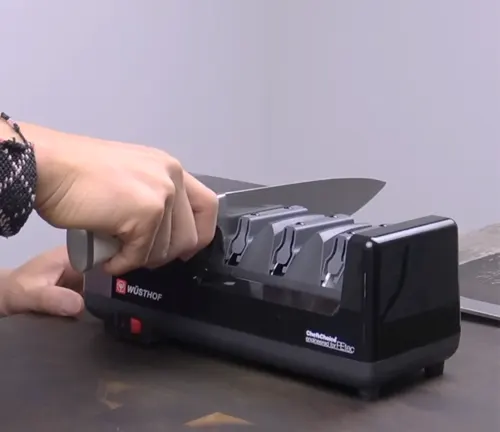
Each technique requires a bit of practice to master, but once you do, you’ll be able to keep your knives in top condition, ensuring efficient and safe cutting in your kitchen. Remember, the key to a well-sharpened knife is not just the method used, but the care and attention to detail applied during the sharpening process.
Advanced Tips and Tricks

Sharpening a knife like a professional involves more than just the basic technique. Here are some advanced tips and tricks that can help you achieve a razor-sharp edge and maintain your knives in optimal condition:
Understanding the Burr
- The burr is a slight fold of metal on the opposite side of the edge you’re sharpening. Feeling a burr along the entire edge ensures that you’ve sharpened the knife enough on that side.
- Develop a sense of touch to identify the burr, as it’s a key indicator that the edge has reached the apex of the blade.
Angle Consistency
- Maintaining a consistent angle is crucial for an evenly sharpened edge. Use angle guides if you’re a beginner or trust your muscle memory as you gain more experience.
- Consider using a sharpening jig for precise angle control, especially useful for beginners.
Stone Flattening
- Regularly flatten your whetstone. A flat stone surface is critical for even sharpening. Use a stone flattener or a coarse diamond stone to maintain the flatness of your whetstone.
Stropping
- After sharpening, use a leather strop to polish the edge and remove any remaining burr. This can significantly increase the sharpness and smoothness of the blade.
- Stropping can be done on leather, denim, or even newspaper. The key is to use a very light touch and maintain the angle.
Micro-Beveling
- Consider adding a micro-bevel to your knife. This is a very slight angle change (usually an additional 2-3 degrees) at the very edge of the blade.
- Micro-bevels can add durability to the edge and are easily maintained with a few swipes on a honing rod.
Dry Sharpening
- Experiment with dry sharpening on certain types of stones. Some sharpeners prefer the feedback and feel of dry stones, although this is not suitable for all stone types.
Sharpening Different Blade Types
- Familiarize yourself with different blade types and their specific sharpening needs. Japanese knives, for instance, often have a different angle and harder steel compared to Western knives.
Use of Lubricants
- Experiment with different lubricants on your whetstone. While water is standard, some stones may benefit from oil, and others can be used dry.
Maintain a Sharpening Log
- Keep a log of your sharpening sessions including the type of knife, the stone grit used, the number of strokes, and observations about the knife’s performance after sharpening. This can help refine your technique over time.
Safety and Care
- Always prioritize safety. Keep your workspace clean and free of distractions.
- Take care of your stones and sharpening equipment. Store them properly and clean them after each use.
- Remember, knife sharpening is a skill that improves with practice. Don’t be afraid to experiment and find what techniques and tools work best for you and your knives.
Conclusion
Sharpening and maintaining your knives is a valuable skill. With regular care, your knives will perform excellently, making your cooking experience safer and more enjoyable. A well-maintained knife not only ensures precision in your culinary endeavors but also reflects your dedication to the craft of cooking. Moreover, the process of sharpening can be a rewarding and meditative practice, enhancing your connection to your tools and the dishes you create. Remember, a sharp knife is a safe knife, and a testament to a well-equipped and responsible chef.
Frequently Asked Questions (FAQ’s)
- What is the best angle to sharpen a kitchen knife?
The ideal angle for sharpening most kitchen knives is between 15 to 20 degrees on each side. However, this can vary based on the specific type of knife and its intended use. - How often should I sharpen my knives?
This depends on how frequently you use them and what you’re cutting. A general guideline is to sharpen them every 1-2 months for regular home use, but they may need honing with a steel more frequently to maintain the edge. - Can I sharpen a serrated knife the same way I sharpen a straight-edged knife?
Serrated knives require a different sharpening approach, typically using a round sharpening rod that fits into the serrations. They don’t need sharpening as often as straight-edged knives. - What is the difference between honing and sharpening a knife?
Honing straightens and realigns the edge of a knife without removing significant material, maintaining the sharpness. Sharpening actually removes material from the blade to create a new edge and should be done less frequently. - Is it better to sharpen knives with a whetstone or an electric sharpener?
Whetstones offer more control and can produce a finer edge, but require skill and practice. Electric sharpeners are convenient and easier for beginners, but may not offer the same level of precision as a whetstone. - How can I tell if my knife is sharp enough?
A sharp knife should easily slice through a sheet of paper without tearing. For kitchen knives, they should effortlessly cut through tomatoes or other soft foods without crushing. - Do all types of knives need the same level of sharpness?
No, different knives have different optimal levels of sharpness based on their use. For example, a delicate fillet knife may require a sharper edge than a rugged cleaver. - Can sharpening a knife too often damage it?
Over-sharpening can shorten the lifespan of a knife by removing too much material. It’s important to sharpen only as needed and to use the correct technique to preserve the blade. - What’s the best way to maintain a knife’s edge after sharpening?
Regularly honing the knife with a honing rod, using the correct cutting surfaces (e.g., wooden or plastic cutting boards), and avoiding misuse can help maintain the edge. - Is there a risk of damaging my knives with a whetstone if I’m a beginner?
There’s a learning curve to using a whetstone, and mistakes can lead to uneven edges or scratches on the blade. Starting with a practice knife and using angle guides can help mitigate the risk while learning.
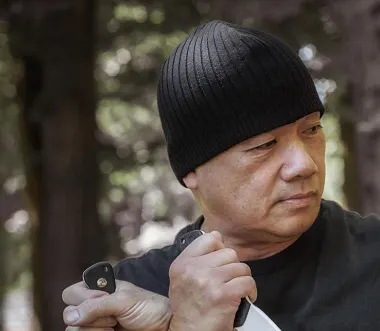
Kerith Simon
As an expert with over ten years of dedicated experience in knife defense, my professional journey is anchored in a profound commitment to the safety and empowerment of individuals through specialized education. My expertise is not only grounded in practical self-defense techniques but also extends to a scholarly understanding of knife functionality, which I have meticulously documented in my authoritative series, This work stands as a testament to my deep engagement with the subject, offering readers critical insights into the nuances of knife selection and usage across various contexts. My approach to teaching and content creation is informed by a rigorous methodology and a continuous pursuit of knowledge, ensuring that the strategies and insights I provide are both effective and scientifically sound. Through a combination of hands-on workshops, comprehensive seminars, and well-researched publications, I strive to elevate the standard of knife defense education, making it accessible and reliable for those seeking to enhance their security and proficiency in this essential skill.

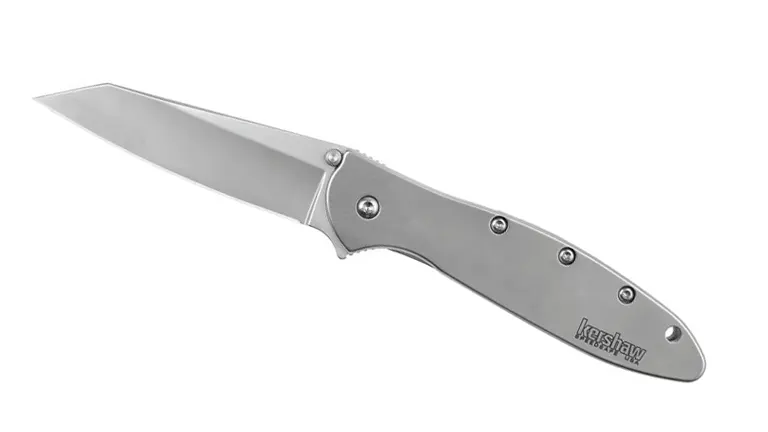
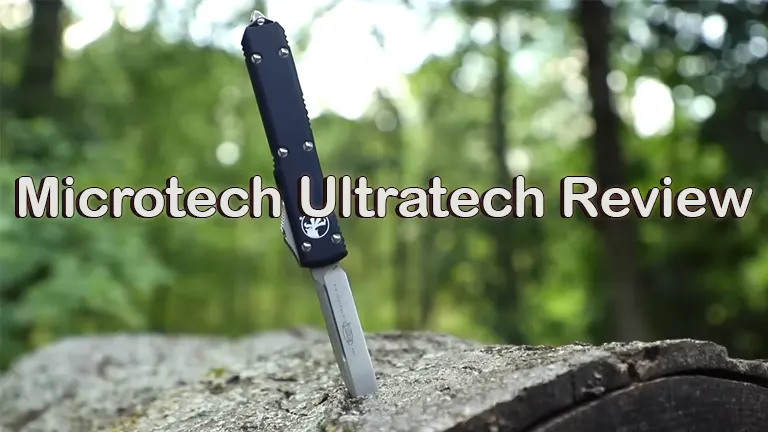
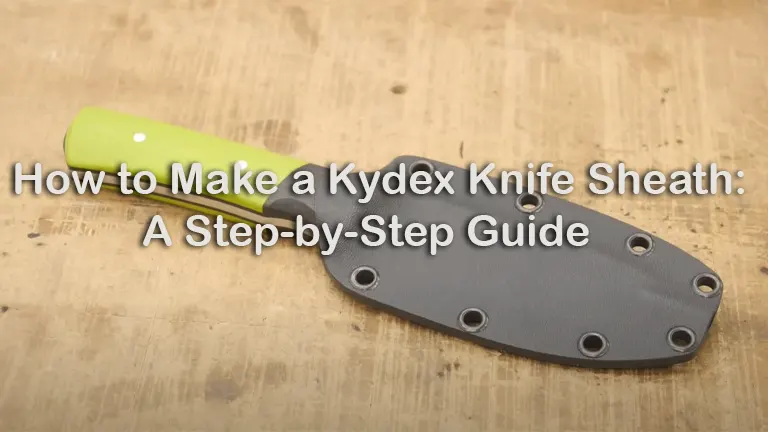
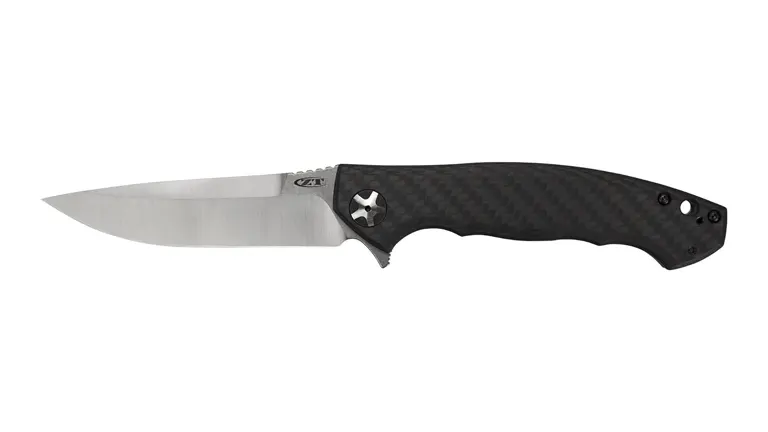



Leave your comment